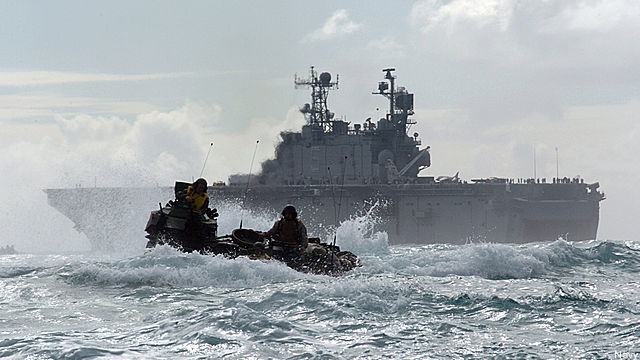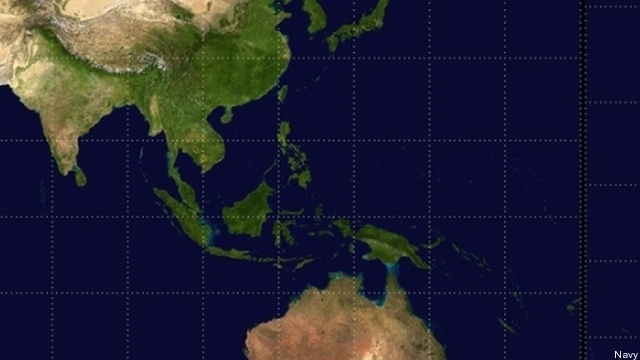Pacific Strategy: Adm. Locklear ‘Spreads The Theater’
Posted on

PORTSMOUTH, VA: For decades, America’s Pacific strategy has focused on the northeast corner of that vast theater, with major forces and bases in Korea and Japan. But as economies boom and tensions rise in Southeast Asia, the Pentagon has played catch-up, deploying more forces to Australia, Singapore, and Guam.
At a conference here last week, the four-star chief of Pacific Command made clear he sees the whole 4,000-mile arc from north to south as a strategically interconnected whole. The emerging term of art for this approach: “Spreading the theater.”
What’s the strategy behind the slogan? As different as they are in language, culture, and geography, Southeast Asia and Northeast Asia are linked by sea lanes, economics, and history. All of them must also cope with an increasingly assertive China, a problem they’ve been faced with on and off for over 2,000 years. So US policy can take advantage of those shared interests and anxieties; US action in Northeast Asia can have positive repercussions in Southeast Asia, and vice versa; and shifts on either flank can affect the balance with Beijing. “They’re interconnected,” Adm. Samuel Locklear told me after his public remarks to the National Defense Industrial Association conference on expeditionary warfare.
But there’s no East Asian equivalent of NATO, I protested. While Australia, Japan, the Philippines, South Korea, New Zealand, and Thailand are all treaty allies of the United States — and Taiwan is a de facto ally — they’re not all allies of each other. So, I asked the admiral, if China starts shooting at the Japanese in the north over the Senkaku Islands, do South Pacific partners like the Philippines help out? If China starts shooting at the Filipinos over the Scarborough Shoal, do our Northeast Asian allies risk Beijing’s wrath by taking action? In short, do our allies all hang together or all hang separately?
“I always stay away from hypothetical questions,” Locklear replied, “but what I would say is that the interests of the nations in the region are tied together pretty tightly, as ours [are] with the region’s — including those of China…. Everything’s interlocked.”
Unlike the Cold War between economically separate Western and Soviet blocs, everybody in the Asia-Pacific is heavily invested in each others’ economies, including the US and China. “It’s a different world we’re in because it’s not a clear-cut divide between one set of driving interests and the other,” Locklear told me.
Admittedly, that kind of interconnection didn’t help Europe avoid World War I, but Locklear argued that East Asia wouldn’t repeat that unhappy history. “We have a rolling bilateral relationship with China,” he told me. “So I don’t mean to make it sound Pollyannish or that the situation couldn’t potentially be dangerous, but I think we’re generally [moving] in a positive direction on the Pacific as it relates to security matters — generally. That doesn’t mean we won’t have fits and starts.”
What Locklear is getting at is that the US “rebalance” to the Pacific is not just about reassuring our partners that we’ve got their backs against an increasingly assertive China: It’s also about reassuring China that it can find its place in the sun through peaceful means. If you want a visual image for this strategy, think of a long arc connecting our allies and partners, from Seoul in the north to Manila in the middle to Darwin, Australia in the south. But then you have to superimpose upon this north-south arc another line running straight east-west to represent our sometimes-fumbling outreach to China.

“The world’s not quite sure what to do with China, if it can do anything at all,” Locklear told the audience at the NDIA conference. After decades of dramatic growth, he said, “they’re now becoming a global security concern or a global security partner, depending on how you look at it.”
East Asia’s problem is that there is no structure like NATO or the European Union providing coherence and guidance. Given the region’s sheer size and diversity – it has eight times as many people as Europe and at least four major language families compared to Europe’s one (Indo-European) – it’s unlikely there ever will be. “We have to kind of figure out how to make what’s there work as best as we can,” Locklear told the group. There is a host of overlapping bilateral alliances and local multilateral organizations, mostly notably the Association of Southeast Asian Nations (ASEAN), to work with. “The best we can do in this century is kind of pull those together,” he said, so if a crisis erupts, “it doesn’t just tear apart.”
“Because if it tears apart,” Locklear said grimly, “we’ve got seven of the 10 largest armies in the world, we’ve got all the largest navies in the world, and we’ve got the most heavily militarized part of the world here, because they’ve got the cash.”
The risk of war weighs heavily on US military minds. In fact, the first person I heard talk of “spreading the theater” – though he attributed the concept to Locklear – was the Marine Corps’ Deputy Commandant, Lt. Gen. Kenneth Glueck, and he was definitely thinking in terms of major conflict, not just peacetime engagement.
In a head-on conflict in the East China Sea – Glueck didn’t say “with China,” but it was pretty clear what he meant – “you’re looking at more or less attrition warfare,” he told me in a sidebar conversation at the conference. (China’s land-based missile arsenal can hit US forces well out to sea and our airbases in Japan and South Korea). In that scenario, “we’re going tit for tat,” Glueck said, “and we can’t play that game. So what we’re going to end up doing, you talk with Adm. Locklear, he’ll spread the theater. He’ll deter, deny, and do other operations to throw them off game.” In classical military terminology, this is called exploiting “exterior lines”: China may be in the center of the theater, closer to everything that counts than we are – an advantage known as “interior lines” – but the US can turn the Middle Kingdom’s central position into a liability by striking on both flanks at once.
“Air-Sea Battle was more or less designed to focus on the Pacific,” Glueck went on, referring to the Navy and Air Force-led concept for long-range air, sea, space, and cyber combat against a high-tech foe. “[But] if you spread that theater, then you need more than just… Air-Sea Battle. You’re going to need ground forces, you’re going to need amphibious forces.” (That synergy of stand-off weapons and muddy boots on the ground, Glueck added, is also why the “Strategic Landpower” effort led by the Army, Marines, and Special Operations Command is “basically complementary” to Air-Sea Battle rather than in competition with it.)
“It’s really a full-theater problem,” Glueck told me, in which we have to balance our traditional focus on Northeast Asia with a new emphasis on Southeast Asia and the South China Sea: “That’s where I think maritime forces can have a major role.”
“How many islands are in Indonesia? 17,000,” Locklear told the audience at the NDIA conference the next day. “7,000… in the Philippines.” Most of these are tiny and uninhabited, but they still matter as naval chokepoints and land bases, and they still matter legally because even establishing even a minimal presence can help justify claims to fishing and oil-drilling rights in the surrounding waters.
“It’s not just about large land masses,” Locklear told the group. “[This] is the littoral region of the world.” Such geography, incidentally, is the natural environment of the US Marine Corps.
It is also, Locklear argued, a natural fit for the shallow-draft Littoral Combat Ship (LCS), a controversial smaller vessel now on its first, somewhat troubled operational deployment to Singapore. “I advocated for this [deployment] heavily when I was director of navy staff,” Locklear said. “Yes, it’s the first one, it’s an R&D ship, it’s not perfect,” he acknowledged, “[but] it had the effect that it needed to have….and we’re going to send more here, I hope.”
Moving out more ships, troops, and aircraft to expand US presence in the Pacific is strategically essential, Locklear said, especially at a time when fiscal crisis and political gridlock might cause many abroad to doubt American strength.
“The thing that I’ve observed is different about the Asia-Pacific is they assess and judge things not in the short view, but in the long view… much more than we do,” Locklear told reporters after his public remarks. “For them, it is much more about what they really see rather than what they hear, and I think we’ve been able to demonstrate even through this difficult time of sequestration the US’s perseverance in the Asia-Pacific.”
“If you’re not there, you don’t influence ’em,” Locklear had told the group just minutes before. After decades of emphasis on Northeast Asia, he said, “we’ve got to get forces that in different places to pull different partners and different allies in. If they want our skin in the game, we want their skin in the game.”
For all his focus on this kind of peacetime engagement, Locklear made clear he’s thinking about warfighting as well. “So let’s talk about the A2/AD threat a little bit….anti-access/area denial,” the admiral told the conference. That’s the Pentagon term of art for the kind of sophisticated layered defenses – from cyber attack to long-range missiles to old-fashioned naval mines – that countries like China and Iran are building to keep the US at bay. (China calls this approach “active defense” and “counter-intervention”). “It’s not one actor; it’s all over the world and it’s going to proliferate,” Locklear said. “Whoever builds it is going to sell it somewhere else, and so we have to contend with it.”
That does not mean we need to panic about A2/AD, however, “We need to look at it not as an iron dome,” Locklear went on, “but as a block of Swiss cheese that gets more dense as you get closer to the center…. The way you deal with it is you find the holes in the Swiss cheese and widen them.”
“Those holes in the Swiss cheese… that’s where our capability, our money, ought to go,” the admiral said. “You’ve got to buy the things that increase our asymmetric advantage, and we have many, many, many of them. [Everything else], let it go, because we’re just throwing money into places that aren’t going to make a difference in our warfight.”
“This is why I think the industry needs to listen to COCOMs [combatant commanders], because we’ll tell you where those holes are,” Locklear said pointedly to the many defense contractors in the audience. “Sometimes it runs counter to the program that industry put together 10 years ago, and they’re stuck on that.”
“The world’s changed,” Locklear summed up, and US strategy must change with it. That means new and more focused investments of diminishing resources in new capabilities. That means shifting limited forces to different areas. That means, above all, a new sense of strategic humility.
In East Asia today, Locklear said, “we’re not the biggest guy on the block, we’re just not, and we’ve to come to grips with it. Doesn’t mean we’re not a big guy, but we’re not the biggest….so how do we look for those asymmetric advantages that allow us to continue to protect US interests?”
Subscribe to our newsletter
Promotions, new products and sales. Directly to your inbox.
